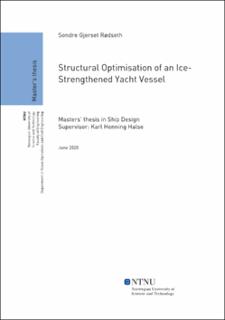| dc.contributor.advisor | Halse, Karl Henning | |
| dc.contributor.author | Rødseth, Sondre Gjerset | |
| dc.date.accessioned | 2021-09-24T19:17:26Z | |
| dc.date.available | 2021-09-24T19:17:26Z | |
| dc.date.issued | 2020 | |
| dc.identifier | no.ntnu:inspera:60471529:37439702 | |
| dc.identifier.uri | https://hdl.handle.net/11250/2782172 | |
| dc.description.abstract | Dette prosjektet ble delt inn i to ulike metoder for strukturell optimalisering av en is-klassifisert yacht som skulle bytte klassenotasjon fra isklasse C til polarklasse 6. Oppgaven ble gitt av firmaet Marin Teknikk AS.
I metode én, ble Microsoft Excel benyttet for å utvikle en kalkulasjonsapplikasjon med hensikt å regne ut dimensjoner for elementer inkludert i to ulike klassenotasjoner. Den ferdige applikasjonen består av ark for input, kalkulasjoner og resultatvisning.
I den andre metoden, ble applikasjonen Siemens NX brukt til å gjennomføre en parametrisk model og "finite element" analyse. I del én av metoden testes et beregnet panel fra kalkuleringsapplikasjonen, og ved små justeringer av input tilfredsstiller panelet kravet til sin egen klassenotasjon. Panelet er lokalisert i midtskips isbelte. I del to gjennomføres en studie med ulike tester for å finne minimumsendring av isklasse C-panelet for å møte kravene for islasten polarklasse 6-panelet må tåle. Etter fem ulike tester, ble det funnet et minimumstillegg som gjorde at panelet tilfredsstilte kravet for den høyere klassenotasjonen.
Avslutningsvis i oppgaven vises det en sammenligning av de to gjennomførte metodene, fokusert på gjennomføring og vekt. | |
| dc.description.abstract | The purpose of the thesis was to perform two different methods for structural optimisation of ice-strengthened yacht vessel changing class notation from Ice Class C to Polar Class 6. The problem statement is given by Marin Teknikk AS.
The first method of the thesis used Microsoft Excel to create an application calculating element dimensions for two class notations. The application consists of input, calculation and result sheets.
The second method uses Siemens NX for parametric panel design and finite element analyses. The first part of the method tests an output panel from the calculation application, and by tuning the input parameters, the panel satisfies the requirements of its classification. The panel is localised in the midship ice-belt. In the second part, a case study is completed to investigate if a minimum addition to the Ice Class C panel could make it satisfy the requirements of a polar classification; Polar Class 6. After studied five different cases, a satisfying panel for polar classification is found.
At the end of the thesis, a comparison of the two methods implemented is carried out, focusing on when to apply the different methods and the additional weight for the respective methods. | |
| dc.language | | |
| dc.publisher | NTNU | |
| dc.title | Structural Optimisation of an Ice-Strengthened Yacht Vessel | |
| dc.type | Master thesis | |
